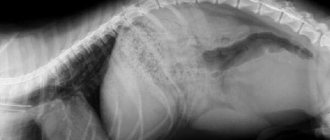What makes a dog whine
Before weaning your pet from whining, it is worth finding out why he does it. It should be borne in mind that all sounds that an animal makes can be a means of communication, and whining is no exception. By whining, a pet conveys various emotions and moods, and we can talk about the following:
- nervousness, expression of impatience;
- emotional overexcitation;
- fear, panic, severe stress - this often happens during thunderstorms, fireworks, fireworks, when the dog finds himself in an unfamiliar environment;
- manifestation of positive emotions: fun, pleasure;
- used as a way to attract attention;
- experiencing loneliness - many four-legged animals “sin” by starting to howl and whine when everyone leaves;
- signs of pain, discomfort;
- feeling of guilt, so the dog can apologize for inappropriate behavior;
- a burst of accumulated energy;
- reactions to irritating factors.
Most often, babies who are experiencing separation from their brothers and mommy begin to whine. Whining, they call their mother. This is a completely normal reaction of a bored puppy, and future owners should be prepared for the fact that the dog will worry most often at night and when left alone.
It will take some time for your pet to adapt, to get used to new conditions, people and other animals. After a while he will stop worrying and whining. To speed up the adaptation period, it is recommended to surround the baby with attention, take care of him and leave him alone as little as possible. This is especially true for babies who were separated from their mother earlier than expected.
In addition, physiological causes of whining cannot be ruled out. While many dogs have patience, some have difficulty with it. A dog may ask to go outside earlier than expected for a variety of reasons: it has drunk a lot of liquid, is taking diuretics, is cold, has developed diarrhea... Puppies and pregnant bitches can also be “itchy.” In addition, the dog may whine out of impatience if the owner, in the pet’s opinion, is taking too long to get ready for a walk.
Pathological causes and their treatment
Unfortunately, in some situations there is no time for jokes, because the dog can tremble due to much more serious reasons.
- Viral diseases. As a rule, they are accompanied by an increase in temperature. The animal is shivering severely, it refuses food, and behaves apathetically. Often these symptoms become integral companions of hepatitis, plague, parvovirus enteritis, and encephalomyelitis. If you suspect your pet is seriously unwell, you should immediately seek help from a veterinarian. The doctor will examine the patient, take a blood sample, and prescribe effective treatment. For the most part, tailed patients are prescribed a course of antibiotics, immunostimulating drugs, and vitamins.
- Metabolic disease. The cause may be a lack of magnesium, potassium and other substances. Newly whelped females are at risk. To confirm the diagnosis, the clinic will do blood biochemistry. If the results of the study are positive, the doctor will prescribe a therapeutic diet, a course of vitamins and nutritional supplements.
- Hypothyroidism. Insufficient thyroid function can have serious consequences. Don't waste time and make an appointment with your doctor as soon as possible. Only a veterinarian can bring hormonal levels back to normal. As a rule, in the case of this disease, hormone replacement therapy and special nutrition are prescribed.
- Food poisoning. If your dog picks up all sorts of nasty things on the street, and you are still walking without a muzzle, sooner or later it will end very badly. The main symptoms of severe intoxication are vomiting, diarrhea, refusal to eat, fever, and trembling. At the first sign, run to the clinic, because the hours are counting. Most likely, your pet will have a gastric lavage and put on a drip with medicine. In case of severe poisoning, the animal will be left under observation for a couple of days in a hospital.
- Hypoglycemia. Low blood sugar is common in small dogs and elderly dogs suffering from diabetes. The dog trembles, sleeps a lot, moves little and generally looks lethargic. The doctor will send your pet's blood to a laboratory to determine the cause of the hypoglycemia and prescribe effective treatment. Depending on the results, the dog will be prescribed either insulin injections or a therapeutic diet.
- Heatstroke. The temperature outside shows 30 degrees, and your pet is shaking as if from the cold? This should be alarming. The dog probably suffered heatstroke. This condition is very dangerous for the animal and requires immediate intervention from a specialist.
- Parasites. When infected with helminths, the dog trembles during defecation, itches, becomes noticeably nervous, and whines. These symptoms include vomiting, dull fur, and rashes on the body. After examination at the clinic, your pet will be prescribed antiparasitic drugs, various immunostimulants, ointments, and shampoos.
- Allergy. Another possible cause of tremor. The dog is trembling and tearing the skin with its claws, trying to relieve the itching - it’s time to show your pet to the doctor. A course of antihistamines, ointments, powders will alleviate the patient’s condition.
- Pathology of internal organs. Disturbances in the functioning of the heart, kidneys and other organs, as well as some diseases of the spine can be very painful. No wonder the dog is shaking from pain and discomfort. In some cases, you can get by with simple massages, compresses and supportive medications. In others, surgery will be required.
Which breeds are prone to whining?
Busy people should not take as a pet a representative of the following breeds, which are highly human-oriented and cannot be alone:
- basset hound;
- Bernese Mountain Dog;
- bichon frize;
- boxer;
- Beauceron;
- bulldog - American, French;
- Brussels Griffon;
- bull terrier;
- Irish Setter;
- Golden retriever;
- Yorkshire Terrier;
- Cane Corso;
- Spaniel – King Charles, English Cocker;
- Maltese;
- pug;
- Continental Toy Spaniel (Papillon, Phalene);
- spaniel;
- poodles;
- Toy Terrier;
- Saint Bernard;
- chihuahua;
- Chowchow.
When purchasing such a pet, the owner, who does not have enough time to communicate with him, will encounter not only whining. In addition, whining may turn out to be the “lesser evil”, since bored dogs can cause harm, and large dogs do this on a grand scale.
Whining at night may be a sign that the dog is not getting proper exercise. This applies to young, energetic and efficient dogs with an active psyche. Active working breeds include all service dogs, sled dogs, sports dogs, hunting dogs, and some herding dogs.
Cowardly four-legged animals can also whine if it seems to them that the people or relatives around them pose a threat. Usually this quality is not associated with the breed of the pet, but most often owners cultivate it in decorative, miniature pets - caring for, protecting and in every possible way protecting from external irritants, often doing a “disservice” to the dog.
In addition, dogs that in the past had to wander or endure beatings and humiliation from the owner can be cowardly. Pets that lack the owner’s attention can also whine, and thus they attract the owner.
How to deal with night whining
An adult dog will sleep peacefully, especially if he feels well, and the day went according to the usual algorithm - with timely walking, feeding and communication with the owner. Most often, puppies show restlessness at night, and only if we are talking about babies recently weaned from their mother. But they are worried not only by a change in environment, but also by fear, loneliness, foreign smells and sounds.
Puppies whine very pitifully, making thin, ear-piercing sounds. Particularly compassionate owners cannot stand it and take the baby into their bed, which experienced dog breeders and breeders do not recommend doing. One or two times is enough for the dog to get used to a cozy, warm place, and it will be very difficult to wean him off the bed.
In addition, if a puppy at the age of 1-3 months begins to whine and howl at night, left alone in the house or a separate room, you should not scold, punish, or use physical force. Sometimes even raising his voice causes severe stress in the dog. But such behavior does not require encouragement; it is even contraindicated; it is important to act consistently and be persistent.
To wean your baby from whining, you can resort to the following:
- you should take care of a comfortable and quiet place for your pet - he needs to be equipped with a bed, it can be a mattress or a house suitable for the size of the dog;
- Until the puppy gets used to the new place, you should not leave him alone for a long time, and it is also not recommended to lock him in a cage or other confined space;
- It is desirable that the dog does not experience stress and avoids negative emotions - during the adaptation period and during socialization, the pet should be in a calm, favorable environment.
It is undesirable to take a puppy away from its mother before 1.5 months of age, but if such a situation is unavoidable, the owner will have to play the role of parent at first. It is recommended to stroke the baby when he whines and shows anxiety, massage his tummy, and praise him when he behaves well.
For the first time, you can place the dog’s bed next to his own sleeping place, but gradually it should be moved away, bringing it closer to the area where the grown-up and adult pet will rest.
You can ease the adaptation period by using an object familiar to the puppy. You can ask the breeder for a rag from the bedding on which the bitch and offspring were located, a toy, or a piece of cardboard. They are placed near the baby's bed, this will help calm the baby and give him confidence.
A tiny toddler can be placed near an improvised device for maintaining temperature - a bottle filled with warm water, wrapped in a diaper, or a heating pad.
If your pet has grown up and is accustomed to home and family, but continues to howl and whine at night, you can leave him with a light or night light on. When this behavior is caused by boredom, it is worth offering your pet a new toy, dental bone, or other entertainment. When the dog gets naughty and plays enough, he will definitely want to sleep.
Within 1-2 weeks after the dog has arrived in its new home, you can begin training it. First of all, he must learn his nickname, then the first commands follow: “place”, “to me”, “sit”. A little later, the dog is introduced to prohibition commands - “fu”, “no”. They should be spoken moderately loudly, clearly, in an even tone. And when the puppy completes tasks correctly, he should receive encouragement - affection, a treat or a friendly tone.
So that the baby does not misbehave in the absence of his owners, does not howl and whine at the door, he must be provided with toys - interesting and varied, they should be periodically replaced by adding something new. Such entertainment will allow the dog to spend excess energy, and in addition, it will protect furniture and wallpaper from damage.
When the quarantine ends and the baby has received all the vaccinations, he should be taken out for walks, gradually making them longer. At the same time, due attention should be paid to socialization. The puppy must meet new people, brothers, go to unfamiliar places and ride on public transport. All this contributes to the proper development of the dog and the formation of its personal characteristics. A well-mannered and trained dog will not whine at the sight of strangers or dogs.
Boredom
Another very simple reason why a puppy may whine is boredom. In this situation, you should show the baby his toys, find time to walk and play with him.
If a dog whines from boredom at night, the owner should give the dog a good walk and “play” the animal in the evening before bed. Inexperienced owners often make the mistake of staying close to the baby to “comfort” or letting him into their bed at night. Having done this once, you can be sure that the dog will remember this behavior and will constantly demand the attention and company of the owner. In this situation, retraining a pet is much more difficult.
A puppy or adult dog whines when alone indoors
Often, not only loneliness makes a dog whine, but even being in a closed room. Moreover, the dog can not just whine, but howl protractedly and even scream heart-rendingly. In this case, a strict approach is required as this behavior is considered unacceptable. If the owner feels sorry for and reassures his four-legged friend every time, he will decide that he is acting correctly and deserves encouragement.
If your pet is trying to get attention by whining, then the best option is to ignore it. Gradually, the dog will realize that in this way it not only does not achieve what it wants, but also provokes the owner’s dissatisfaction.
But sometimes dogs show miracles of self-control, literally infuriating all family members by making very unpleasant sounds for a long time. If patience has run out, you can open the door, say “place” in a stern voice and give the command “fu!” It is recommended to use a similar algorithm until the dog calms down. When nothing changes the situation, it is recommended to increase punishments. Representatives of different breeds require their own suitable method.
Whining as a form of communication
Dogs cannot communicate their sorrows to humans in words. Therefore, pets try to attract the owner’s attention by whining. It is a set of sounds that express certain feelings and emotions that carry important information for the animal. For them, it is a way of communication, similar to barking and growling.
An experienced owner, who cares about the condition of his pet, knows what exactly and in what situation a particular sound signal emitted by an animal can mean, and, if necessary, respond in a timely manner and provide assistance.











